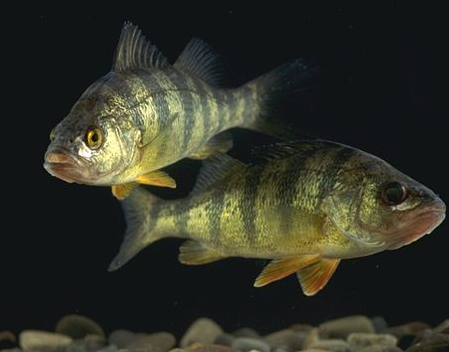Yellow perch were discovered in Goose Lake inside Yellowstone National Park in 1919. Photo by Wikimedia Commons.
Wait. Don’t panic. There aren’t any yellow perch inside the boundaries of Yellowstone National Park.
At least not anymore.
I’m in the final throes of researching a book on the wild trout of Yellowstone that’ll hit bookshelves next spring (shameless plug), and I’ve come across some really interesting historical documents regarding the early stocking efforts inside the park, from when Yellowstone was designated as the world’s first national park in 1872 through the early 1900s. Yellow perch, according to the document, “Fishes of Yellowstone National Park,” first published in 1914 by W.C. Kendall, an assistant with the U.S. Bureau of Fisheries, and subsequently updated, were found in Goose Lake in the Firehole River drainage in 1919.
Here’s an exerpt from that early report:
“The yellow perch has a wide eastern distribution. It is common in the Great Lakes and the tributaries of the upper Mississippi River and in coastwise streams and lakes from Nova Scotia to North Carolina.
In 1919 this fish was found by the senior author to abound in Goose and Feather Lakes in the park. Its presence there is apparently traceable to an unofficial, unauthorized plant made many years ago by a Montana citizen, who is said to have obtained a consignment of yellow perch from the State of Washington, into which State the species had been introduced some years before.
In the park lakes the yellow perch attains a length of a foot and is most readily caught by the use of small spinners cast from shore and rapidly drawn in. Only a few of the park authorities have been aware of the occurrence of this fish in local waters. It can not be regarded as a desirable addition to the fish life of the park, and its spread to other waters than those now inhabited should be prevented. It is not usually reputed to be a game fish, and its voracious habits make it a menace to young trout. When fresh from cold water, it is one of the best of pan fishes, being firm-meated and of delicious flavor.”
The good news is that Goose Lake is free of non-native yellow perch. The even better news is that it’s now home to a brood stock of west slope cutthroat trout that were native to the headwaters of the Missouri River (the Firehole, Gibbon, Madison and Gallatin rivers are all Missouri River headwater streams, and they all start in Yellowstone National Park). The National Park Service is currently working on a number of projects in Yellowstone to bring west slope cutthroats back to their native waters.
More good news? In the park’s early years, fisheries managers tried to spice up the angling in the park, so they brought in some crazy fish to see if they could make that happen. In addition to the non-native brown, brook, rainbow and lake trout that still live within the park today, efforts were made to introduce largemouth bass to the Gibbon River (1893), and landlocked Atlantic salmon to Yellowstone Lake (1908). Thankfully, neither stocking was successful.
For anglers, Yellowstone is a special place, and that’s largely because of its native trout. Today, through its Native Fish Conservation Plan, the Park Service is working to undo some of the damage inflicted on the park’s ecosystem by the introduction of non-native fish. I’d tell you more, but I have a book to finish.
— Chris Hunt



